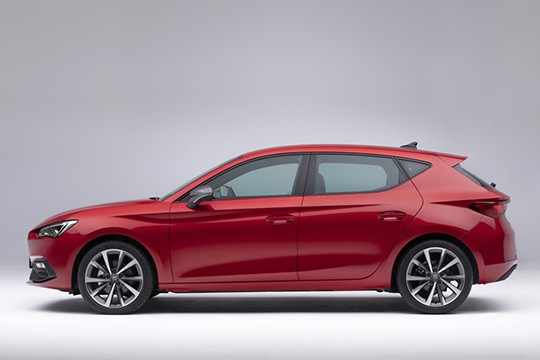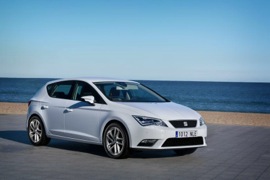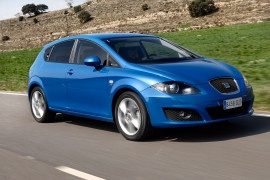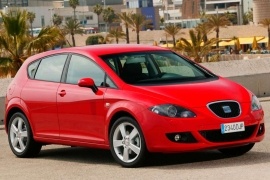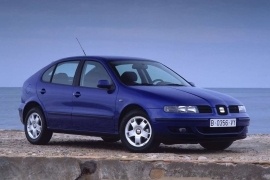SEAT Leon Models/Series Timeline, Specifications & Photos
First production year: 2000
Engines: Hybrid, Gasoline, Natural gas, Diesel
Body style: Hatchback
SEAT unveiled the fourth generation of its successful Leon lineup in 2020 at the Martorell factory at the beginning of 2020, and it was available in two shapes: a hatchback and a station wagon. Unlike the third generation of the Leon, this one was no longer available in a three-door configuration.
The world was already aware of the upcoming pandemic situation, and automakers tried to release their latest models as soon as they could. In Spain, things were somehow relaxed since only in mid-March the lockdown started, and at the end of January, SEAT launched the Leon Mk IV. The car was based on the same MQB Evo platform shared with the Volkswagen Golf, Skoda Octavia, and Audi A3. But unlike its siblings, the Leon had the most aggressive exterior design. In addition, it was also the starting point for the sporty brand Cupra, which previously was just a trim level for the SEAT brand.
At the front, the 2020 Leon featured an angular design with a shield-like grille adorned by a chicken-wire pattern design and surrounded by a gray-satin rim. Its LED headlights incorporated triangular-shaped daytime running lights, and the headlamps featured a narrower inner area than on their outer side. The lower bumper sported a lower grille flanked by fake air scoops that sported the optional LED fog lamps. From its profile, the Leon showed sculptured doors and a sloped-down roofline with a tiny triangular third window behind the rear doors. At the back, the tilted forward tailgate featured a roof spoiler where the third brake light found its place. Underneath the rear bumper, SEAT placed fake exhausts. Still, the most attractive side of the rear fascia was the red light bar that crossed the vehicle from side to side, connecting the taillights.
The interior design sported a minimalist design but with a display for the instrument cluster instead of analog dials. Atop the center stack, SEAT used the same touchscreen as the Golf, and just like its sibling, it didn’t feature a turning knob for the volume. Most buttons were touch-sensitive, and that made them difficult to operate during nighttime driving situations. The standard front seats in the base model were quite supportive, but the automaker also offered a set of high-bolstered ones for the upper trim levels, such as the FR. In the back, there was room for three adults on the split-folding seat bench, but with limited legroom for the middle-seated passenger.
Under the hood, the automaker installed a choice of gasoline or diesel engines, which sent their power to the front wheels only via five or six-speed manuals or six or seven-speed automatics (dual clutch). Surprisingly, even if the Golf and the A3 were available with an all-wheel-drive system, the SEAT was not. Instead, those who wanted to get the car with traction on all four corners could get the Cupra-branded version.
The Spanish brand SEAT introduced the third generation of its compact hatchback Leon on the market in 2012 and surprised European customers with the car’s new design language that moved away from the rounded shapes of its predecessors.
Volkswagen tried to get back on its feet after it had to pay a huge amount of money for the Dieselgate, and for that, it needed smart planning and engineering solutions. As a result, the German automaker made the MQB platform that was largely used by most of its brands, such as the SEAT, Skoda, and Audi. The Leon was one of these products and continued to attract its customers thanks to its bold design language and affordable pricing policy. Still, it has its drawbacks due to the low-quality materials used inside the vehicle. But customers knew that already from the Leon previous two generations.
After the Italian designer Walter da Silva left the helm of the SEAT’s design department in the competent hands of Alejandro Mesonero-Romanos, the new chief stylist of the Spanish brand went into a different direction previewed by the IBE, IBL, and IBX concept cars. The third generation of the Leon featured angular-shaped headlights with a claw-like shape and inner-mounted LED daytime running lights. It was a daring method to emphasize the car’s new styling and was emphasized by the reversed-trapezoidal shape of the upper grille. In addition, in the apron, the automaker placed a second trapezoidal grille that mirrored the one above it. From its profile, the sculptured door panels offered a dynamic look for the vehicle, with two creases that emerged from the rear doors onto the quarter panels. Moreover, the upward window line created a triangular shape for the third side window mounted in the car’s C-pillars. At the back, the raked forward tailgate adorned with a roof spoiler was already part of the Leon design signature, being present also on the previous generations of the car.
Inside, the automaker couldn’t use the best quality materials available on the market, so the modern design of the cockpit was affected. Still, customers could order the vehicle with Alcantara or leather upholstery, depending on the engine version and trim level. But the light-gray plastic trims were nothing to write home about. At the front, the driver and their side passenger sat on bolstered bucket seats that provided adequate support during high-speed cornering maneuvers but were not the sportiest in the house; those were reserved for the Cupra range. In the back, the split-folding (60/40) bench seat offered enough room for three passengers, thanks to the low profile of the center tunnel that crossed the car from front to back. Fronting the driver was an analog instrument cluster with two large dials for the rev counter and the speedometer that flanked a TFT display. In addition, the automaker offered a color touchscreen atop the center stack, between the center vents, for the infotainment system.
Under the hood, the third generation of the Leon offered a wide choice of gasoline and diesel engines, all turbocharged, paired with five- or six-speed manual gearboxes or with a seven-speed automatic (dual-clutch) transmission. Power went to the front wheels only since SEAT deleted the option for all-wheel-drive systems. That was reserved for the upscale brand Cupra.
SEAT Leon 5 doors 1.6L TDI 5MT FWD (105 HP)
SEAT Leon 5 doors 1.6L TDI 5MT FWD (90 HP)
SEAT Leon 5 doors 1.6L TDI 6MT FWD (110 HP)
SEAT Leon 5 doors 1.6L TDI 7AT FWD (105 HP)
SEAT Leon 5 doors 2.0L TDI 6MT FWD (150 HP)
SEAT Leon 5 doors 2.0L TDI 6MT FWD (184 HP)
Unveiled at the Geneva Motor Show in 2009, the Leon was completely redesigned and offered a variety of versions and engines to suit every need.
The range available was of the most complete on the market, with the offer including 19 sport versions and 9 engine options.
Five gasoline and four Diesel engines were on the list, as well as four transmission options: 5-speed and 6-speed manual, 6-speed and 7-speed automatic.
The facelift version brought a sharper look with the restyled front bumper and the grille. Other changes included a smaller Seat logo, as well as refined headlights and taillights.
At the back, the new Leon had a larger rear window to increase visibility.
The interior was also redesigned and upgraded with higher quality materials, as well as the design of the dashboard and the center console. A new steering wheel was available and the leather upholstery got a brand new color.
The base version of the Leon was equipped with the 1.4-liter 85 hp and the 1.9-liter 90 hp engines. The standard safety features included ABS, traction control, ESP, electronic brake assist and driver and passenger airbags, as well as head and side airbags.
The Reference trim level added tire pressure monitoring, air conditioning and asorted door mirrors and handles.
The Style trim level included the Reference’s features and added cornering foglights, a leather-wrapped steering wheel, cruise control, climate control, new alloy rims and rear power windows.
The Sportier trim level available included new sport seats with new upholstery, a sport suspension, the FR logo on the leather gear knob as well as on the steering wheel, a better audio system and dark glass.
SEAT introduced the second generation of its compact hatchback Leon in 2005, thus adjusting its production line with the Euro 4 standards.
After a successful first generation, the second model came based on the same recipe of using Volkswagen's Golf platform. That led to lower production costs for both vehicles, since they shared the development expenses. The result was a Latin design with German engineering. That shouldn't go wrong.
The 2005 Leon was a mix of arched lines and sharp angles. Its organic-inspired headlights with sharp inner and outer margins were penned using curved lines. That led to a different styling for the grille, which was smaller than the Leon's previous generation. But that wasn't a problem since the lower grille, placed in the bumper, providing more cooling area. Also, depending on the options, the car featured fog lamps in the apron's side scoops. From its profile, the carmaker added a sculptured line that ran from the front fenders and arched down towards the rear doors. The rear door's handles were hidden in the C-pillar in the window's area to create a coupe-like image.
If the car's exterior was considered a youthful, attractive feature, the interior was nicely penned but built with budget materials. Thus, the hard plastic areas covered the center stack and the center console. The design, on the other hand, was adequate, with the center stack tilted toward the driver. Depending on the trim level and options, SEAT provided the Leon with bucket seats at the front, while in the back, all versions received a 60/40 split-folding bench.
Under the hood, the 2010 Leon received a range of gasoline and diesel engines provided by Volkswagen. Depending on the options, SEAT offered its hatchback with an automatic transmission but not with an all-wheel system, like Leon's first generation.
A cross between a coupe and a hatchback, the new Leon was introduced in 1991.
The sporty exterior design was given by the muscular rear end with the rear spoiler. At the front, the narrow headlights completed the aggressive appearance.
Quite unusual for Seat, the Leon was the fastest car in its class in production at the time, featuring a powerful engine that developed 180 hp. The power was sent to all four wheels through a 6-speed gearbox. This model was not available on all markets.
The four-wheel-drive version available on specific markets featured a Haldex rear-wheel system that electronically measured the amount of torque distributed to the rear wheels, connecting both axles when required depending on the weather conditions.
With a wide range of engines available, the buyers could choose between 7 options: 3 diesel and 4 gasoline units.
For 2000, the Leon was available in three trim levels, with the range topping version featuring a lower chassis, bigger alloys and even sport seats.
While the interior was rather dull, everything was well laid out and the quality of the materials used throughout the cabin was superb.
Besides numerous options available, the Leon could be further personalised with a variety of exterior paint colors available, 14 in total. 3 interior finishes were also available.
The Seat Leon was still a practical vehicle for daily driving, while still offered a fun ride with its punchy engines.
